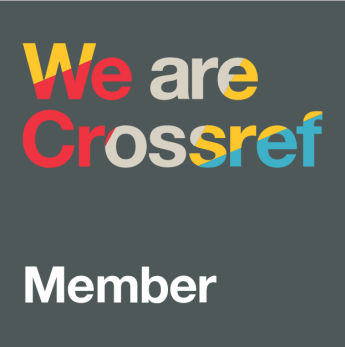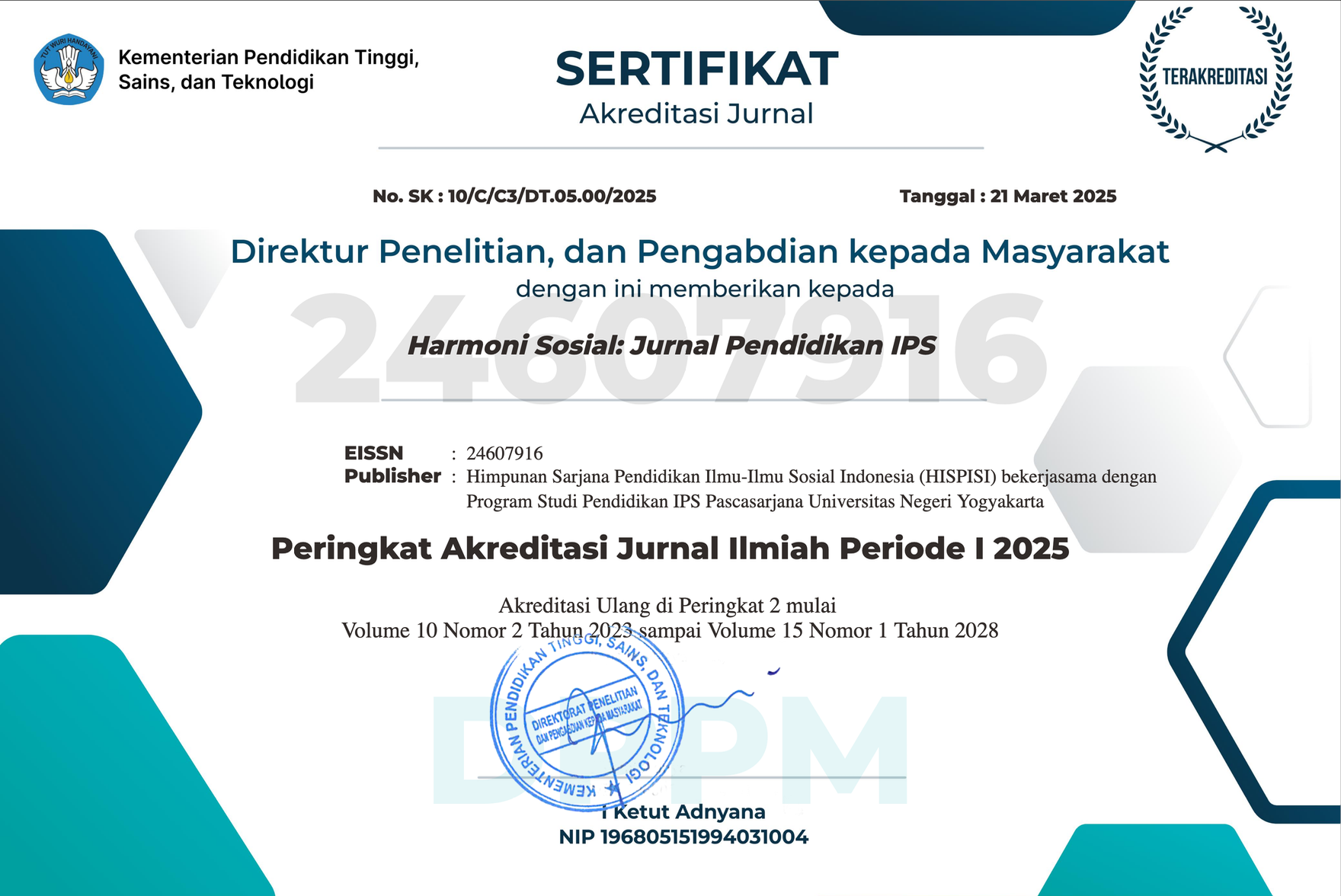Living laboratory of regional potential for social studies learning to enhance students' collaboration and communication
Downloads
21st-century education requires collaboration and communication skills as students' core competencies, but social studies learning at the junior high school level still tends to be textual and lacks local potential. This study uses a qualitative approach with a case study design at SMPN 1 Wuluhan, Jember Regency, involving social studies teachers and grade VIII students through participatory observation, semi-structured interviews, documentation, and questionnaires to 60 students, with data analysis of Miles, Huberman, and Saldaña models validated through triangulation methods and member checking. The results show that the potential of the Wuluhan area—such as Papuma Beach, Watangan Hill, Reog craft center, and Charcoal Factory—provides an authentic learning experience that strengthens the connection of social studies materials with local reality; 91.6% of students consider field activities to be more meaningful than classroom learning. Collaboration skills are improving well, particularly in respecting friends' opinions (85%). In comparison, communication skills improve in listening (83%), although the courage to ask questions is still low (72%). Interviews and observations confirm that field learning encourages active participation, confidence, and more natural social interaction. The main supporting factors for implementation are the diversity of local potential, student enthusiasm, and community support, while obstacles include weather, transportation costs, and time constraints. Overall, this study confirms that the living laboratory is efficacious in improving the collaboration and communication skills of junior high school students through participatory contextual learning, while strengthening cultural identity and learning motivation, with the note that successful implementation requires strategies to mitigate technical constraints and synergistic support between schools, communities, and local governments.
Downloads
Ankori-Karlinsky, R., Kache, P. A., Abreu, G., Fox, J., Smith, J., Huddell, A. M., Dutta, M., Schoen, J. M., Johnston, A., Pereira, K. A. C., Krichilsky, R., Tulloch, J., Rahman, M., Lantigua, M., & Kross, S. (2025). Running a successful ecology and environmental justice summer program: A recipe for collaboration among high-schools, local non-profit organizations and ecologists. Urban Ecosystems, 28(2), 5. https://doi.org/10.1007/s11252-024-01652-9
Arefin, M. A., Nabi, M. N., Sadeque, S., & Gudimetla, P. (2021). Incorporating sustainability in engineering curriculum: A study of the Australian universities. International Journal of Sustainability in Higher Education, 22(3), 576–598. https://doi.org/10.1108/IJSHE-07-2020-0271
Arias, A., Pennese, C., Grijalba, O., & Sidqi, Y. (2025). Application of living lab concept: where, how and for what is being used in Europe to support energy, social and environmental transition. Sustainability, 17(6), 2727. https://doi.org/10.3390/su17062727
Baccarne, B., Schuurman, D., Mechant, P., & Marez, L. De. (2014). The role of urban living labs in a smart city. ISPIM Conference Proceedings. https://core.ac.uk/download/pdf/55735925.pdf
Bergey, B. W., & Ranellucci, J. (2021). Motivation profiles of urban preservice teachers: Relations to socialization, initial career perceptions, and demographics. Contemporary Educational Psychology, 64, 101936. https://doi.org/10.1016/j.cedpsych.2020.101936
Carlson, J., Johnston, L., Westra, B., & Nichols, M. (2013). Developing an approach for data management education: A report from the data information literacy project. International Journal of Digital Curation, 8(1), 204–217. https://doi.org/10.2218/ijdc.v8i1.254
Carter, E., Malcomess, B., & Rositzka, E. (2022). Mapping the sensible. De Gruyter. https://doi.org/10.1515/9783110769012
Creighton, T. (2004). Leading from below the surface: A non-traditional approach to school leadership. Corwin Press.
Darling-Hammond, L., Flook, L., Cook-Harvey, C., Barron, B., & Osher, D. (2020). Implications for educational practice of the science of learning and development. Applied Developmental Science, 24(2), 97–140. https://doi.org/10.1080/10888691.2018.1537791
Dunne, P. M., Lusch, R. F., & Carver, J. R. (2013). Retailing (8th ed.). National Retail Federation.
Duran, M. (2022). Learning technologies. Springer International Publishing. https://doi.org/10.1007/978-3-031-18111-5
Hadar, L. L., Ergas, O., Alpert, B., & Ariav, T. (2020). Rethinking teacher education in a VUCA world: Student teachers’ social-emotional competencies during the Covid-19 crisis. European Journal of Teacher Education, 43(4), 573–586. https://doi.org/10.1080/02619768.2020.1807513
Haidusek-Niazy, S., & Carpenter, R. E. (2025). Crisis-driven organizational learning: the role of informal reverse mentoring. Development and Learning in Organizations: An International Journal. https://doi.org/10.1108/DLO-01-2025-0032
Heorhievska, Z. A. (2021). Distant education and its role in modern society. Pedagogical Sciences Reality and Perspectives, 1(79), 89–94. https://doi.org/10.31392/NPU-nc.series5.2021.79.1.18
Jackson, D., & Bridgstock, R. (2021). What actually works to enhance graduate employability? The relative value of curricular, co-curricular, and extra-curricular learning and paid work. Higher Education, 81(4), 723–739. https://doi.org/10.1007/s10734-020-00570-x
Johnson, D. W., Johnson, R. T., & Stanne, M. B. (2000). Cooperative learning methods: A meta-analysis. https://www.academia.edu/download/33787421/Cooperative_Learning_Methods_A_Meta-Analysis.pdf
Kayes, D. C. (2002). Experiential learning and its critics: Preserving the role of experience in management learning and education. Academy of Management Learning & Education, 1(2), 137–149. https://doi.org/10.5465/amle.2002.8509336
Keiler, L. S. (2018). Teachers’ roles and identities in student-centered classrooms. International Journal of STEM Education, 5(1), 34. https://doi.org/10.1186/s40594-018-0131-6
Kim, H. W., & Kim, M. K. (2021). A case study of children’s interaction types and learning motivation in small group project-based learning activities in a mathematics classroom. Eurasia Journal of Mathematics, Science and Technology Education, 17(12), em2051. https://doi.org/10.29333/ejmste/11415
Kohl, K., Hopkins, C., Barth, M., Michelsen, G., Dlouhá, J., Razak, D. A., Abidin Bin Sanusi, Z., & Toman, I. (2022). A whole-institution approach towards sustainability: a crucial aspect of higher education’s individual and collective engagement with the SDGs and beyond. International Journal of Sustainability in Higher Education, 23(2), 218–236. https://doi.org/10.1108/IJSHE-10-2020-0398
Kolb, D. (2000). The process of experiential learning. In Strategic Learning in a Knowledge Economy (pp. 313–331). Elsevier. https://doi.org/10.1016/B978-0-7506-7223-8.50017-4
le Brasseur, R. (2023). Virtual site visits: Student perception and preferences towards technology enabled experiential learning. International Journal of Emerging Technologies in Learning (IJET), 18(02), 115–140. https://doi.org/10.3991/ijet.v18i02.32013
López-Gopar, M. E., Sughrua, W. M., Cordova, V. H., González, A. J. R., & Vera, G. R. (2022). Mexican student-teachers’ “English” language praxicum: Decolonizing attempts. International Journal of Educational Research, 115, 102022. https://doi.org/10.1016/j.ijer.2022.102022
Mohammadhosseini, H., Alyousef, R., & Md. Tahir, M. (2021). RETRACTED: Towards sustainable concrete composites through waste valorisation of plastic food trays as low-cost fibrous materials. Sustainability, 13(4), 2073. https://doi.org/10.3390/su13042073
Morales, D. R., Conover, M. M., You, S. C., Pratt, N., Kostka, K., Duarte-Salles, T., Fernández-Bertolín, S., Aragón, M., DuVall, S. L., Lynch, K., Falconer, T., van Bochove, K., Sung, C., Matheny, M. E., Lambert, C. G., Nyberg, F., Alshammari, T. M., Williams, A. E., Park, R. W., … Suchard, M. A. (2021). Renin–angiotensin system blockers and susceptibility to COVID-19: An international, open science, cohort analysis. The Lancet Digital Health, 3(2), e98–e114. https://doi.org/10.1016/S2589-7500(20)30289-2
Mulà, I., & Tilbury, D. (2025). Teacher education for sustainable development: Catalysing change across the professional landscapes in Europe. Environmental Education Research, 31(7), 1481–1508. https://doi.org/10.1080/13504622.2025.2475143
Murphy, S. (2023). Academic disengagement of African American male students in classroom settings: A qualitative descriptive study [Franklin University]. https://www.proquest.com/openview/29dc536ff274270ea1d62d315fda0e5c/1?cbl=18750&diss=y&pq-origsite=gscholar
Nyamuryekung’e, M. K., Walli, N., Ismail, N. A., Housseine, N., Adebayo, P. B., & Ali, A. (2025). Rapid transition to virtual learning in postgraduate medical Eeducation during the COVID-19 Pandemic in Tanzania: A qualitative study. Annals of African Medicine, 24(1), 146–151. https://doi.org/10.4103/aam.aam_41_24
Perez, L. G., Uline, C. L., Johnson, J. F., James-Ward, C., & Basom, M. R. (2011). Foregrounding fieldwork in leadership preparation: The transformative capacity of authentic inquiry. Educational Administration Quarterly, 47(1), 217–257. https://doi.org/10.1177/0011000010378614
Perrotta, K., & Hochuli, C. (2025). Everything is place: critical reflections on race, community-based learning, and becoming critical scholars in a Ph.D. program. International Journal of Qualitative Studies in Education, 1–20. https://doi.org/10.1080/09518398.2025.2500921
Ponijan, P., Wulandari, D., & Hardhienata, S. (2025). Increasing teachers’ creativity through strengthening mutual cooperation and work motivation. Journal of World Science, 4(6), 629–640. https://doi.org/10.58344/jws.v4i6.1425
Quaranta, G., Woodcock, A., Marucci, A., & Desole, M. (2025). Women towards success: Organisational changes through gendered innovation living labs. ISPIM Innovation Symposium, 1–20. https://conferencesubmissions.com/ispim/proceedings/individual_papers/1442657456_Paper.pdf
Rodriguez, D., & Montesdeoca, H. P. (2025). Perception of future teachers on the influence of poverty. Journal of Applied Learning & Teaching, 8(1). https://doi.org/10.37074/jalt.2025.8.1.8
Rodriguez, S. L., Doran, E., Updegraff, A., Sabrowsky, J., & Stevens, A. R. (2024). Design thinking in online spaces: How students develop their engineering identities. International Journal of Education in Mathematics, Science and Technology, 12(5), 1273–1292. https://doi.org/10.46328/ijemst.4312
Scherer, R., Howard, S. K., Tondeur, J., & Siddiq, F. (2021). Profiling teachers’ readiness for online teaching and learning in higher education: Who’s ready? Computers in Human Behavior, 118, 106675. https://doi.org/10.1016/j.chb.2020.106675
Sors, F., Tomé Lourido, D., Parisi, V., Santoro, I., Galmonte, A., Agostini, T., & Murgia, M. (2019). Pressing crowd noise impairs the ability of anxious basketball referees to discriminate fouls. Frontiers in Psychology, 10:2380. https://doi.org/10.3389/fpsyg.2019.02380
Tannenbaum, S. I., & Wolfson, M. A. (2022). Informal (field-based) learning. Annual Review of Organizational Psychology and Organizational Behavior, 9(1), 391–414. https://doi.org/10.1146/annurev-orgpsych-012420-083050
Thompson, E. L., Gonzalez, M. R., Scardamalia, K. M., Pham, A. V., Adams, A. R., Gonzalez, A., Rizzo Scarfone, G. V., Lehman, S. M., Kaiver, C. M., Hawes, S. W., & Gonzalez, R. (2025). Structural determinants of school discipline: Examining state-level racial bias and neighborhood opportunity. Journal of the American Academy of Child & Adolescent Psychiatry, 64(11), 1305–1316. https://doi.org/10.1016/j.jaac.2024.10.017
Tran, T. C. (2024). Explorations of the structure-agency dialectic across three STEM education contexts focused on equity and identity development [University of Colorado]. https://www.proquest.com/openview/788b2e3bcdf560408541b76250b3f91f/1?cbl=18750&diss=y&pq-origsite=gscholar
Vandehey, A. (2025). Improving climate literacy in the classroom using place-based education - An evaluation of the climate safe neighborhood redesign unit at millennial tech middle school. escholarship. https://escholarship.org/content/qt7vj3c08m/qt7vj3c08m.pdf
Vassiloudis, I. (2024). Can primary school pupils become researchers? A research project on the accessibility of public spaces. Interdisciplinary Journal of Environmental and Science Education, 20(3), e2414. https://doi.org/10.29333/ijese/14693
Voogt, J., Fisser, P., Pareja Roblin, N., Tondeur, J., & van Braak, J. (2013). Technological pedagogical content knowledge – a review of the literature. Journal of Computer Assisted Learning, 29(2), 109–121. https://doi.org/10.1111/j.1365-2729.2012.00487.x
Wegener, E. K., Bergschöld, J. M., Bergh, S., van Berlo, A., Schmidt, C. W., Konidari, A., & Kayser, L. (2024). Considerations when designing inclusive digital health solutions for older adults living with frailty or impairments. JMIR Formative Research, 8, e63832. https://doi.org/10.2196/63832
Wilcox, K. C., Durand, F. T., Lawson, H. A., Schiller, K. S., Leo, A., Khan, M. I., & Mola Ávila, J. A. (2024). Principals’ discursive framing and communications and educators’ job satisfaction during the COVID-19 pandemic. Journal of School Leadership, 34(6). https://doi.org/10.1177/10526846241271448
Wilujeng, A. P., Putri, N. S., & Hati, D. A. P. (2025). The experience of a mother whose toddler had stunted growth but has successfully recovered : A phenomenology study. PROFESSIONAL HEALTH JOURNAL, 7(1), 1–11. https://doi.org/10.54832/phj.v7i1.936
Zhang, L., Basham, J. D., & Yang, S. (2020). Understanding the implementation of personalized learning: A research synthesis. Educational Research Review, 31, 100339. https://doi.org/10.1016/j.edurev.2020.100339
Zhao, R., Wang, Y., Li, X., Wang, Q., Qiu, R., & Liu, X. (2025). Psychological resilience and social anxiety in aphasia: the mediating role of interpersonal relationship perception. Current Psychology. https://doi.org/10.1007/s12144-025-08155-6

This work is licensed under a Creative Commons Attribution-ShareAlike 4.0 International License.
The Authors submitting a manuscript do so on the understanding that if accepted for publication, copyright publishing of the article shall be assigned to Harmoni Sosial: Jurnal Pendidikan IPS
 | Harmoni Sosial: Jurnal Pendidikan IPS by http://journal.uny.ac.id/index.php/hsjpi is licensed under a Creative Commons Attribution-ShareAlike 4.0 International License. |









 ISSN Print
ISSN Print









